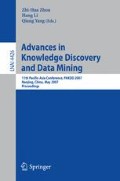Abstract
Feature extraction is one of the hot topics in face recognition. However, many face extraction methods will suffer from the “small sample size” problem, such as Linear Discriminant Analysis (LDA). Direct Linear Discriminant Analysis (DLDA) is an effective method to address this problem. But conventional DLDA algorithm is often computationally expensive and not scalable. In this paper, DLDA is analyzed from a new viewpoint via QR decomposition and an efficient and robust method named DLDA/QR algorithm is proposed. The proposed algorithm achieves high efficiency by introducing the QR decomposition on a small-size matrix, while keeping competitive classification accuracy. Experimental results on ORL face database demonstrate the effectiveness of the proposed method.
Access this chapter
Tax calculation will be finalised at checkout
Purchases are for personal use only
Preview
Unable to display preview. Download preview PDF.
References
Samal, A., Iyengar, P.A.: Automatic recognition and analysis of human faces and facial expressions: a survey. Pattern Recognition 25(1), 65–77 (1992)
Zhao, W., Chellappa, R., Phillips, J.: Subspace linear discriminant analysis for face recognition. Technical Report, CS-TR4009, Univ. of Maryland (1999)
Zhao, W., et al.: Face recognition: A literature survey. ACM Computing Surveys 35(4), 395–458 (2003)
Fukunaga, K.: Introduction to statistical pattern recognition, 2nd edn. Academic Press, Boston (1990)
Fisher, R.: The use of multiple measures in taxonomic problems. Ann. Eugenics 7, 179–188 (1936)
Belhumeur, P.N., Hespanha, J.P., Kriengman, D.J.: Eigenfaces vs. Fisherfaces: Recognition using class specific linear projection. IEEE Trans. Pattern Analysis and Machine Intelligence 19(7), 711–720 (1997)
Yang, J., et al.: KPCA plus LDA: A Complete Kernel Fisher Discriminant Framework for Feature extraction and Recognition. IEEE Trans. Pattern Analysis and Machine Intelligence 27(2), 230–244 (2005)
Yang, J., Yang, J.Y.: Why can LDA be performed in PCA transformed space? Pattern Recognition 36, 563–566 (2003)
Tian, Q., et al.: Image classification by the foley-sammon transform. Opt. Eng. 25(7), 834–840 (1986)
Hong, Z.Q., Yang, J.Y.: Optimal discriminant plane for a small number of samples and design method of classifier on the plane. Pattern Recognition 24(4), 317–324 (1991)
Cheng, Y.Q., Zhuang, Y.M., Yang, J.Y.: Optimal fisher discriminant analysis using the rank decomposition. Pattern Recognition 25(1), 101–111 (1992)
Swets, D.L., Weng, J.: Using discriminant eigenfeatures for image retrieval. IEEE Trans. on Pattern Analysis and Machine Intelligence 18(8), 831–836 (1996)
Chen, L.F., et al.: A New LDA-based Face Recognition System Which Can Solve the Small Sample Size Problem. Pattern Recognition 33(10), 1713–1726 (2000)
Yang, J., Yu, H., Kunz, W.: An Efficient LDA Algorithm for Face Recognition. In: International Conference on Automation, Robotics, and Computer Vision (ICARCV’2000), Singapore (December 2000)
Zheng, Y., et al.: Effective classification image space which can solve small sample size problem. In: Proc. Of. the 18th Int. Conf. on Pattern Recognition (ICPR’06), vol. 3, pp. 861–864 (2006)
Ye, J.P., Li, Q.: A Two-Stage Linear Discriminant Analysis via QR-Decomposition. IEEE Trans. Pattern Anal. Machine Intell. 2(6), 929–941 (2005)
Golub, G.H., Van Loan, C.F.: Matrix Computations, 3rd edn. The Johns Hopkins Univ. Press, Baltimore (1996)
Author information
Authors and Affiliations
Editor information
Rights and permissions
Copyright information
© 2007 Springer Berlin Heidelberg
About this paper
Cite this paper
Zheng, YJ., Guo, ZB., Yang, J., Wu, XJ., Yang, JY. (2007). DLDA/QR: A Robust Direct LDA Algorithm for Face Recognition and Its Theoretical Foundation. In: Zhou, ZH., Li, H., Yang, Q. (eds) Advances in Knowledge Discovery and Data Mining. PAKDD 2007. Lecture Notes in Computer Science(), vol 4426. Springer, Berlin, Heidelberg. https://doi.org/10.1007/978-3-540-71701-0_37
Download citation
DOI: https://doi.org/10.1007/978-3-540-71701-0_37
Publisher Name: Springer, Berlin, Heidelberg
Print ISBN: 978-3-540-71700-3
Online ISBN: 978-3-540-71701-0
eBook Packages: Computer ScienceComputer Science (R0)

